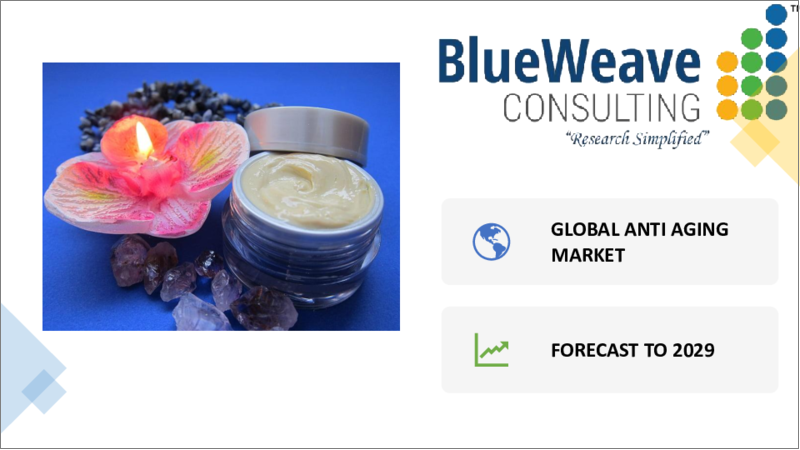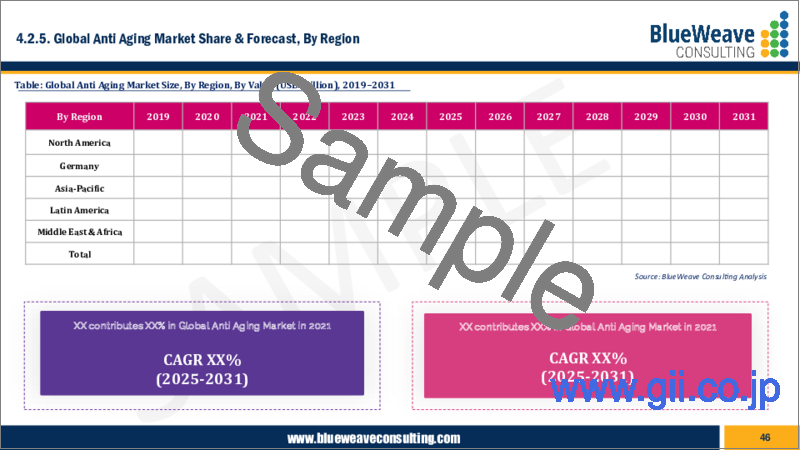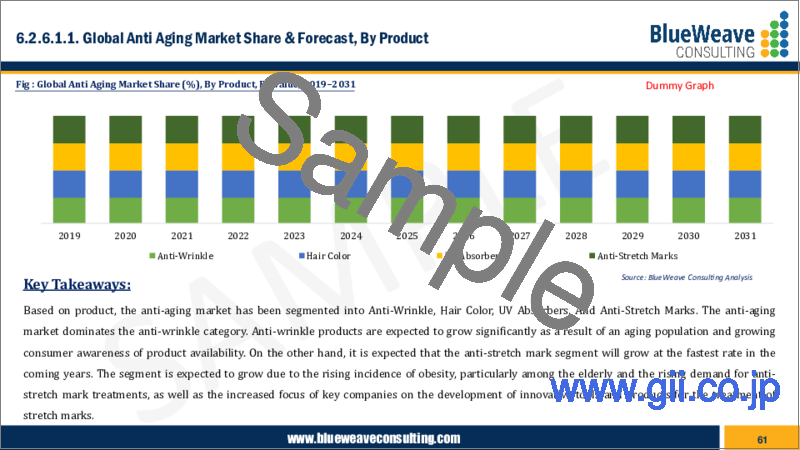|
|
市場調査レポート
商品コード
1658657
アンチエイジングの世界市場:規模、シェア、動向分析、機会、予測(2019年~2029年):製品別、ターゲットグループ別、成分別、治療別、流通チャネル別、地域別Anti-Aging Market - Global Size, Share, Trend Analysis, Opportunity and Forecast Report, 2019-2029, Segmented By Product; By Device; By Treatment; By Demography; By Region |
||||||
|
|||||||
| アンチエイジングの世界市場:規模、シェア、動向分析、機会、予測(2019年~2029年):製品別、ターゲットグループ別、成分別、治療別、流通チャネル別、地域別 |
|
出版日: 2025年01月08日
発行: Blueweave Consulting
ページ情報: 英文 523 Pages
納期: 2~3営業日
|
- 全表示
- 概要
- 目次
世界のアンチエイジング市場は、急速に進む高齢化、若々しい外見への嗜好の高まり、技術進歩の導入、美容整形に対する需要の急増などを主な要因として活況を呈しています。
世界のアンチエイジングの市場規模は、2024年に802億米ドルとなりました。2025年から2031年にかけての予測期間中、CAGR 7.20%という堅調な伸びを示し、2031年には1,244億米ドルに達すると予測されています。世界のアンチエイジング市場の成長を牽引しているのは、スキンケアとウェルネスに対する意識の高まりであり、可処分所得の増加と世界の高齢化がその原動力となっています。非侵襲的な施術や革新的なスキンケア処方など、アンチエイジング製品や治療における技術的進歩が市場の需要をさらに高めています。ソーシャルメディアや美容動向の影響力の高まりは、消費者の外見や若々しさへの関心を高めています。さらに、eコマース・プラットフォームを通じたアンチエイジングソリューションの利用可能性の拡大が、パーソナライズされたスキンケアへの嗜好と相まって、市場の成長を支えています。都市化と高級品へのアクセスに牽引された新興国での需要増加も、世界のアンチエイジング市場の拡大に寄与しています。
アンチエイジング製品や治療のメリットに対する消費者の意識の高まりは、世界のアンチエイジング市場の重要な促進要因です。皮膚の健康、加齢プロセス、利用可能な解決策に関する個人の情報が増えるにつれ、クリーム、美容液、低侵襲治療などの効果的なアンチエイジング製品に対する需要が急増しています。ソーシャルメディア・プラットフォーム、健康キャンペーン、美容インフルエンサーが情報発信を拡大し、消費者が十分な知識を得た上で選択できるようになっています。加えて、予防ケアと若々しい外見への注目の高まりは、可処分所得の増加と相まって、世界の様々な層でアンチエイジングソリューションの採用をさらに促進しています。
ヒアルロン酸は世界のアンチエイジング市場で最大の成分セグメントです。水分を保持し、肌の弾力性を改善する能力で知られるヒアルロン酸は、シワや小ジワを減らし、肌全体の保湿を促進する効果があるため、アンチエイジング用スキンケア製品に広く使用されています。ヒアルロン酸は一般的に、美容液、クリーム、注入可能な皮膚充填剤に含まれており、その人気の一因となっています。ヒアルロン酸の多用途な用途は、非侵襲的治療に対する消費者の需要の高まりと相まって、アンチエイジング・セグメントにおける支配的な成分となっており、市場の大幅な成長を牽引しています。
当レポートでは、世界のアンチエイジング市場について調査し、市場の概要とともに、製品別、ターゲットグループ別、成分別、治療別、流通チャネル別、地域別動向、競合情勢、および市場に参入する企業のプロファイルなどを提供しています。
目次
第1章 調査の枠組み
第2章 エグゼクティブサマリー
第3章 世界のアンチエイジング市場の洞察
- 業界バリューチェーン分析
- DROC分析
- 成長促進要因
- 成長抑制要因
- 機会
- 課題
- 技術の進歩/最近の動向
- 規制の枠組み
- ポーターのファイブフォース分析
第4章 世界のアンチエイジング市場:マーケティング戦略
第5章 世界のアンチエイジング市場:価格分析
第6章 世界のアンチエイジング市場:地域分析
- 世界のアンチエイジング市場、地域分析、2024年
- 世界のアンチエイジング市場、市場の魅力分析、2025年~2030年
第7章 世界のアンチエイジング市場概要
- 市場規模と予測、2019年~2031年
- 市場シェアと予測
- 製品別
- ターゲットグループ別
- 成分別
- 治療別
- 流通チャネル別
- 地域別
第8章 北米のアンチエイジング市場
第9章 欧州のアンチエイジング市場
第10章 アジア太平洋のアンチエイジング市場
第11章 ラテンアメリカのアンチエイジング市場
第12章 中東・アフリカのアンチエイジング市場
第13章 競合情勢
- 主要参入企業とその提供内容のリスト
- 世界のアンチエイジング企業の市場シェア分析、2024年
- 経営パラメータ別競合ベンチマーキング
- 主要な戦略的展開(合併、買収、提携)
第14章 地政学的緊張の高まりが世界のアンチエイジング市場に与える影響
第15章 企業プロファイル(企業概要、財務マトリクス、競合情勢、主要人員、主な競合企業、連絡先、戦略的展望、SWOT分析)
- L'Oreal
- Procter & Gamble
- Estee Lauder
- Shiseido
- Unilever
- Allergan
- Beiersdorf
- Amorepacific
- Johnson & Johnson
- Coty
- Avon
- Revlon
- その他
第16章 主要な戦略的提言
第17章 調査手法
Global Anti-Aging Market Flourishing to Cross USD 124 Billion by 2031
Global Anti-Aging Market is booming primarily due to rapidly aging population with a growing preference for youthful appearance, adoption of technological advancements, and a spurring demand for cosmetic procedures.
BlueWeave Consulting, a leading strategic consulting and market research firm, in its recent study, estimated Global Anti-Aging Market size by value at USD 80.20 billion in 2024. During the forecast period between 2025 and 2031, BlueWeave expects Global Anti-Aging Market size to boom at a robust CAGR of 7.20% reaching a value of USD 124.40 billion by 2031. The growth of Global Anti-Aging Market is driven by rising awareness about skincare and wellness, fueled by increasing disposable incomes and aging populations worldwide. Technological advancements in anti-aging products and treatments, such as non-invasive procedures and innovative skincare formulations, further bolster market demand. The growing influence of social media and beauty trends enhances consumer focus on appearance and youthfulness. Additionally, the expanding availability of anti-aging solutions through e-commerce platforms, coupled with a preference for personalized skincare, supports market growth. An increasing demand in emerging economies, driven by urbanization and access to premium products, also contributes to the expansion of Global Anti-Aging Market.
Opportunity - Growing Consumer Awareness
The growing awareness among consumers about the benefits of anti-aging products and treatments is a significant driver for Global Anti-Aging Market. As individuals become more informed about skin health, aging processes, and available solutions, the demand for effective anti-aging products, such as creams, serums, and minimally invasive treatments, has surged. Social media platforms, health campaigns, and beauty influencers have amplified information dissemination, enabling consumers to make educated choices. Additionally, the rising focus on preventive care and youthful appearance, coupled with increasing disposable incomes, has further propelled the adoption of anti-aging solutions across various demographics globally.
Hyaluronic Acid Segment Dominates Global Anti-Aging Market by Ingredient
Hyaluronic acid is the largest ingredient segment in Global Anti-Aging Market. Known for its ability to retain moisture and improve skin elasticity, hyaluronic acid is widely used in anti-aging skincare products due to its effectiveness in reducing wrinkles and fine lines and promoting overall skin hydration. Hyaluronic acid is commonly found in serums, creams, and injectable dermal fillers, which contribute to its popularity. Its versatile applications, coupled with growing consumer demand for non-invasive treatments, make it the dominant ingredient in the anti-aging segment, driving significant market growth.
Impact of Escalating Geopolitical Tensions on Global Anti-Aging Market
Escalating geopolitical tensions could impact Global Anti-Aging Market by disrupting supply chains, increasing costs for raw materials, and limiting access to key markets. Political instability may hinder international collaborations and research efforts, slowing product innovation. Currency fluctuations and trade barriers can affect pricing strategies, reducing consumer spending power and demand, particularly in emerging markets. Additionally, geopolitical uncertainties can shift consumer priorities, with a focus on essential needs over luxury items like anti-aging products. Conversely, tensions might drive demand for wellness and self-care products as individuals seek to mitigate stress-related aging effects.
Competitive Landscape
Global Anti-Aging Market is highly fragmented, with numerous players serving the market. Major companies dominating the market include L'Oreal, Procter & Gamble, Estee Lauder, Shiseido, Unilever, Allergan, Beiersdorf, Amorepacific, Johnson & Johnson, Coty, Avon, and Revlon. The key marketing strategies adopted by the players are facility expansion, product diversification, alliances, collaborations, partnerships, and acquisitions to expand their customer reach and gain a competitive edge over their competitors in Global Anti-Aging Market.
The report's in-depth analysis provides information about growth potential, upcoming trends, and Global Anti-Aging Market statistics. It also highlights the factors driving forecasts of total market size. The report promises to provide recent technology trends in Global Anti-Aging Market along with industry insights to help decision-makers make sound strategic decisions. Furthermore, the report also analyses the growth drivers, challenges, and competitive dynamics of the market.
Table of Contents
1. Research Framework
- 1.1. Research Objective
- 1.2. Product Overview
- 1.3. Market Segmentation
2. Executive Summary
3. Global Anti-Aging Market Insights
- 3.1. Industry Value Chain Analysis
- 3.2. DROC Analysis
- 3.2.1. Growth Drivers
- 3.2.1.1. Increasing Aging Population
- 3.2.1.2. Rising Disposable Incomes
- 3.2.1.3. Increasing Consumer Awareness
- 3.2.2. Restraints
- 3.2.2.1. High Cost of Products and Procedures
- 3.2.2.2. Potential Side Effects and Risks
- 3.2.3. Opportunities
- 3.2.3.1. Changing Beauty Standards
- 3.2.3.2. Increasing Consumer Awareness
- 3.2.4. Challenges
- 3.2.4.1. Aging-Related Diseases
- 3.2.4.2. Cultural and Social Factors
- 3.2.1. Growth Drivers
- 3.3. Technological Advancements/Recent Developments
- 3.4. Regulatory Framework
- 3.5. Porter's Five Forces Analysis
- 3.5.1. Bargaining Power of Suppliers
- 3.5.2. Bargaining Power of Buyers
- 3.5.3. Threat of New Entrants
- 3.5.4. Threat of Substitutes
- 3.5.5. Intensity of Rivalry
4. Global Anti-Aging Market: Marketing Strategies
5. Global Anti-Aging Market: Pricing Analysis
6. Global Anti-Aging Market: Geographical Analysis
- 6.1. Global Anti-Aging Market, Geographical Analysis, 2024
- 6.2. Global Anti-Aging Market, Market Attractiveness Analysis, 2025-2030
7. Global Anti-Aging Market Overview
- 7.1. Market Size & Forecast, 2019-2031
- 7.1.1. By Value (USD Billion)
- 7.2. Market Share & Forecast
- 7.2.1. By Product
- 7.2.1.1. Serums
- 7.2.1.2. Creams
- 7.2.1.3. Gels
- 7.2.1.4. Others
- 7.2.2. By Target Group
- 7.2.2.1. Male
- 7.2.2.2. Female
- 7.2.3. By Ingredient
- 7.2.3.1. Retinoid
- 7.2.3.2. Hyaluronic Acid
- 7.2.3.3. Alpha Hydroxy Acid
- 7.2.3.4. Others
- 7.2.4. By Treatment
- 7.2.4.1. Body Care Treatment
- 7.2.4.2. Facial care Treatment
- 7.2.5. By Distribution Channel
- 7.2.5.1. Pharmacies
- 7.2.5.2. Stores
- 7.2.5.3. Online Stores
- 7.2.6. By Region
- 7.2.6.1. North America
- 7.2.6.2. Europe
- 7.2.6.3. Asia Pacific (APAC)
- 7.2.6.4. Latin America (LATAM)
- 7.2.6.5. Middle East and Africa (MEA)
- 7.2.1. By Product
8. North America Anti-Aging Market
- 8.1. Market Size & Forecast, 2019-2031
- 8.1.1. By Value (USD Billion)
- 8.2. Market Share & Forecast
- 8.2.1. By Product
- 8.2.2. By Target Group
- 8.2.3. By Ingredient
- 8.2.4. By Treatment
- 8.2.5. By Distribution Channel
- 8.2.6. By Country
- 8.2.6.1. United States
- 8.2.6.1.1. By Product
- 8.2.6.1.2. By Target Group
- 8.2.6.1.3. By Ingredient
- 8.2.6.1.4. By Treatment
- 8.2.6.1.5. By Distribution Channel
- 8.2.6.2. Canada
- 8.2.6.2.1. By Product
- 8.2.6.2.2. By Target Group
- 8.2.6.2.3. By Ingredient
- 8.2.6.2.4. By Treatment
- 8.2.6.2.5. By Distribution Channel
9. Europe Anti-Aging Market
- 9.1. Market Size & Forecast, 2019-2031
- 9.1.1. By Value (USD Billion)
- 9.2. Market Share & Forecast
- 9.2.1. By Product
- 9.2.2. By Target Group
- 9.2.3. By Ingredient
- 9.2.4. By Treatment
- 9.2.5. By Distribution Channel
- 9.2.6. By Country
- 9.2.6.1. Germany
- 9.2.6.1.1. By Product
- 9.2.6.1.2. By Target Group
- 9.2.6.1.3. By Ingredient
- 9.2.6.1.4. By Treatment
- 9.2.6.1.5. By Distribution Channel
- 9.2.6.2. United Kingdom
- 9.2.6.2.1. By Product
- 9.2.6.2.2. By Target Group
- 9.2.6.2.3. By Ingredient
- 9.2.6.2.4. By Treatment
- 9.2.6.2.5. By Distribution Channel
- 9.2.6.3. Italy
- 9.2.6.3.1. By Product
- 9.2.6.3.2. By Target Group
- 9.2.6.3.3. By Ingredient
- 9.2.6.3.4. By Treatment
- 9.2.6.3.5. By Distribution Channel
- 9.2.6.4. France
- 9.2.6.4.1. By Product
- 9.2.6.4.2. By Target Group
- 9.2.6.4.3. By Ingredient
- 9.2.6.4.4. By Treatment
- 9.2.6.4.5. By Distribution Channel
- 9.2.6.5. Spain
- 9.2.6.5.1. By Product
- 9.2.6.5.2. By Target Group
- 9.2.6.5.3. By Ingredient
- 9.2.6.5.4. By Treatment
- 9.2.6.5.5. By Distribution Channel
- 9.2.6.6. Belgium
- 9.2.6.6.1. By Product
- 9.2.6.6.2. By Target Group
- 9.2.6.6.3. By Ingredient
- 9.2.6.6.4. By Treatment
- 9.2.6.6.5. By Distribution Channel
- 9.2.6.7. Russia
- 9.2.6.7.1. By Product
- 9.2.6.7.2. By Target Group
- 9.2.6.7.3. By Ingredient
- 9.2.6.7.4. By Treatment
- 9.2.6.7.5. By Distribution Channel
- 9.2.6.8. The Netherlands
- 9.2.6.8.1. By Product
- 9.2.6.8.2. By Target Group
- 9.2.6.8.3. By Ingredient
- 9.2.6.8.4. By Treatment
- 9.2.6.8.5. By Distribution Channel
- 9.2.6.9. Rest of Europe
- 9.2.6.9.1. By Product
- 9.2.6.9.2. By Target Group
- 9.2.6.9.3. By Ingredient
- 9.2.6.9.4. By Treatment
- 9.2.6.9.5. By Distribution Channel
10. Asia Pacific Anti-Aging Market
- 10.1. Market Size & Forecast, 2019-2031
- 10.1.1. By Value (USD Billion)
- 10.2. Market Share & Forecast
- 10.2.1. By Product
- 10.2.2. By Target Group
- 10.2.3. By Ingredient
- 10.2.4. By Treatment
- 10.2.5. By Distribution Channel
- 10.2.6. By Country
- 10.2.6.1. China
- 10.2.6.1.1. By Product
- 10.2.6.1.2. By Target Group
- 10.2.6.1.3. By Ingredient
- 10.2.6.1.4. By Treatment
- 10.2.6.1.5. By Distribution Channel
- 10.2.6.2. India
- 10.2.6.2.1. By Product
- 10.2.6.2.2. By Target Group
- 10.2.6.2.3. By Ingredient
- 10.2.6.2.4. By Treatment
- 10.2.6.2.5. By Distribution Channel
- 10.2.6.3. Japan
- 10.2.6.3.1. By Product
- 10.2.6.3.2. By Target Group
- 10.2.6.3.3. By Ingredient
- 10.2.6.3.4. By Treatment
- 10.2.6.3.5. By Distribution Channel
- 10.2.6.4. South Korea
- 10.2.6.4.1. By Product
- 10.2.6.4.2. By Target Group
- 10.2.6.4.3. By Ingredient
- 10.2.6.4.4. By Treatment
- 10.2.6.4.5. By Distribution Channel
- 10.2.6.5. Australia & New Zealand
- 10.2.6.5.1. By Product
- 10.2.6.5.2. By Target Group
- 10.2.6.5.3. By Ingredient
- 10.2.6.5.4. By Treatment
- 10.2.6.5.5. By Distribution Channel
- 10.2.6.6. Indonesia
- 10.2.6.6.1. By Product
- 10.2.6.6.2. By Target Group
- 10.2.6.6.3. By Ingredient
- 10.2.6.6.4. By Treatment
- 10.2.6.6.5. By Distribution Channel
- 10.2.6.7. Malaysia
- 10.2.6.7.1. By Product
- 10.2.6.7.2. By Target Group
- 10.2.6.7.3. By Ingredient
- 10.2.6.7.4. By Treatment
- 10.2.6.7.5. By Distribution Channel
- 10.2.6.8. Singapore
- 10.2.6.8.1. By Product
- 10.2.6.8.2. By Target Group
- 10.2.6.8.3. By Ingredient
- 10.2.6.8.4. By Treatment
- 10.2.6.8.5. By Distribution Channel
- 10.2.6.9. Vietnam
- 10.2.6.9.1. By Product
- 10.2.6.9.2. By Target Group
- 10.2.6.9.3. By Ingredient
- 10.2.6.9.4. By Treatment
- 10.2.6.9.5. By Distribution Channel
- 10.2.6.10. Rest of APAC
- 10.2.6.10.1. By Product
- 10.2.6.10.2. By Target Group
- 10.2.6.10.3. By Ingredient
- 10.2.6.10.4. By Treatment
- 10.2.6.10.5. By Distribution Channel
11. Latin America Anti-Aging Market
- 11.1. Market Size & Forecast, 2019-2031
- 11.1.1. By Value (USD Billion)
- 11.2. Market Share & Forecast
- 11.2.1. By Product
- 11.2.2. By Target Group
- 11.2.3. By Ingredient
- 11.2.4. By Treatment
- 11.2.5. By Distribution Channel
- 11.2.6. By Country
- 11.2.6.1. Brazil
- 11.2.6.1.1. By Product
- 11.2.6.1.2. By Target Group
- 11.2.6.1.3. By Ingredient
- 11.2.6.1.4. By Treatment
- 11.2.6.1.5. By Distribution Channel
- 11.2.6.2. Mexico
- 11.2.6.2.1. By Product
- 11.2.6.2.2. By Target Group
- 11.2.6.2.3. By Ingredient
- 11.2.6.2.4. By Treatment
- 11.2.6.2.5. By Distribution Channel
- 11.2.6.3. Argentina
- 11.2.6.3.1. By Product
- 11.2.6.3.2. By Target Group
- 11.2.6.3.3. By Ingredient
- 11.2.6.3.4. By Treatment
- 11.2.6.3.5. By Distribution Channel
- 11.2.6.4. Peru
- 11.2.6.4.1. By Product
- 11.2.6.4.2. By Target Group
- 11.2.6.4.3. By Ingredient
- 11.2.6.4.4. By Treatment
- 11.2.6.4.5. By Distribution Channel
- 11.2.6.5. Rest of LATAM
- 11.2.6.5.1. By Product
- 11.2.6.5.2. By Target Group
- 11.2.6.5.3. By Ingredient
- 11.2.6.5.4. By Treatment
- 11.2.6.5.5. By Distribution Channel
12. Middle East & Africa Anti-Aging Market
- 12.1. Market Size & Forecast, 2019-2031
- 12.1.1. By Value (USD Billion)
- 12.2. Market Share & Forecast
- 12.2.1. By Product
- 12.2.2. By Target Group
- 12.2.3. By Ingredient
- 12.2.4. By Treatment
- 12.2.5. By Distribution Channel
- 12.2.6. By Country
- 12.2.6.1. Saudi Arabia
- 12.2.6.1.1. By Product
- 12.2.6.1.2. By Target Group
- 12.2.6.1.3. By Ingredient
- 12.2.6.1.4. By Treatment
- 12.2.6.1.5. By Distribution Channel
- 12.2.6.2. UAE
- 12.2.6.2.1. By Product
- 12.2.6.2.2. By Target Group
- 12.2.6.2.3. By Ingredient
- 12.2.6.2.4. By Treatment
- 12.2.6.2.5. By Distribution Channel
- 12.2.6.3. Qatar
- 12.2.6.3.1. By Product
- 12.2.6.3.2. By Target Group
- 12.2.6.3.3. By Ingredient
- 12.2.6.3.4. By Treatment
- 12.2.6.3.5. By Distribution Channel
- 12.2.6.4. Kuwait
- 12.2.6.4.1. By Product
- 12.2.6.4.2. By Target Group
- 12.2.6.4.3. By Ingredient
- 12.2.6.4.4. By Treatment
- 12.2.6.4.5. By Distribution Channel
- 12.2.6.5. South Africa
- 12.2.6.5.1. By Product
- 12.2.6.5.2. By Target Group
- 12.2.6.5.3. By Ingredient
- 12.2.6.5.4. By Treatment
- 12.2.6.5.5. By Distribution Channel
- 12.2.6.6. Nigeria
- 12.2.6.6.1. By Product
- 12.2.6.6.2. By Target Group
- 12.2.6.6.3. By Ingredient
- 12.2.6.6.4. By Treatment
- 12.2.6.6.5. By Distribution Channel
- 12.2.6.7. Algeria
- 12.2.6.7.1. By Product
- 12.2.6.7.2. By Target Group
- 12.2.6.7.3. By Ingredient
- 12.2.6.7.4. By Treatment
- 12.2.6.7.5. By Distribution Channel
- 12.2.6.8. Rest of MEA
- 12.2.6.8.1. By Product
- 12.2.6.8.2. By Target Group
- 12.2.6.8.3. By Ingredient
- 12.2.6.8.4. By Treatment
- 12.2.6.8.5. By Distribution Channel
13. Competitive Landscape
- 13.1. List of Key Players and Their Offerings
- 13.2. Global Anti-Aging Company Market Share Analysis, 2024
- 13.3. Competitive Benchmarking, By Operating Parameters
- 13.4. Key Strategic Developments (Mergers, Acquisitions, Partnerships)
14. Impact of Escalating Geopolitical Tensions on Global Anti-Aging Market
15. Company Profiles (Company Overview, Financial Matrix, Competitive Landscape, Key Personnel, Key Competitors, Contact Address, Strategic Outlook, and SWOT Analysis)
- 15.1. L'Oreal
- 15.2. Procter & Gamble
- 15.3. Estee Lauder
- 15.4. Shiseido
- 15.5. Unilever
- 15.6. Allergan
- 15.7. Beiersdorf
- 15.8. Amorepacific
- 15.9. Johnson & Johnson
- 15.10. Coty
- 15.11. Avon
- 15.12. Revlon
- 15.13. Other Prominent Players
16. Key Strategic Recommendations
17. Research Methodology
- 17.1. Qualitative Research
- 17.1.1. Primary & Secondary Research
- 17.2. Quantitative Research
- 17.3. Market Breakdown & Data Triangulation
- 17.3.1. Secondary Research
- 17.3.2. Primary Research
- 17.4. Breakdown of Primary Research Respondents, By Region
- 17.5. Assumptions & Limitations
*Financial information of non-listed companies can be provided as per availability.
**The segmentation and the companies are subject to modifications based on in-depth secondary research for the final deliverable






